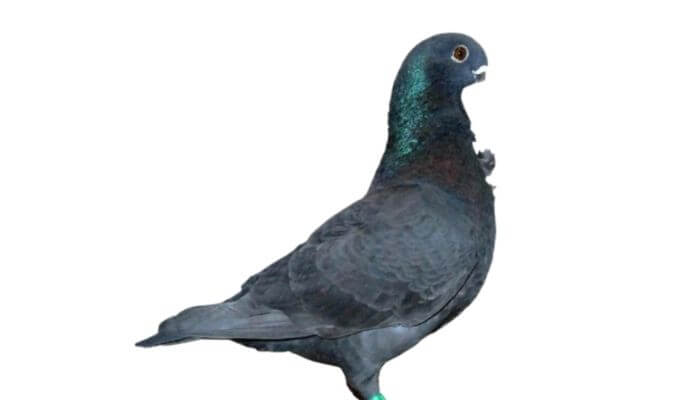The African Owl pigeon is a breed of fancy pigeon that has been subjected to years of selective breeding.
The owl name comes from the size and shape of its beak.
Origins of the African Owl Pigeon
The African owl pigeon originated in Tunisia, but it wasn’t until the 19th century that the bird gained significant popularity.
It was during the 19th century the breed began to be imported to England where it gained much more prominence.

Originally, the breed was referred to as the Foreign Owl because England had already seen a similar type of pigeon, although it was somewhat larger.
This became known as the English owl pigeon and the foreign owl became the African owl pigeon.
African Owl Pigeon Distribution and Habitat
As a selectively-bred bird, the African owl pigeon does not have a wild habitat and its distribution is completely at the vagary of today’s owners and breeders.
For its domestic habitat, if you are going to build a pigeon loft for this breed, they like a home that is dry, spacious and has access to a lot of natural sunlight although they will tolerate most climates.
Appearance of the African Owl Pigeon
The distinguishing feature of all owl pigeons is the crest of feathers that runs down the front of the breast.
This is known as a jabot (but can also be called a cravat or tie) similar to the ornamental frill or ruffles on the front of a shirt or blouse, typically made of lace.
The African Owl pigeon is an average-sized breed that stands about 20 cm (8 inches) tall. It is a compact shape, short and plump, tapering to a wedge at the tail.
Its head is proportionately large, almost ball-shaped with well-rounded cheeks and its beak is short, stout and turned down in shape, and also varies in colour according to the main plumage colour.
Eyes are large and bold in a currant red colour and the bird has fine, white, neat cere. (Red or pink cere are marked down when judging breed standards).
The African owl pigeon has a bold, alert and upright carriage and their frilly crest is accentuated when they walk on their small, neat feet with their chests puffed out.
The standard colours this bird comes in are white, black, blue, silver, dun, lavender, brown, khaki, yellow, red, cream, almond, check, mealy and grizzle.
African Owl Pigeon Character
One of the most noticeable character traits of the African Owl pigeon is the fact that they are incredibly docile, arguably one of the most docile of all the pigeon breeds.
Being raised for the purpose of participating in shows, this docile nature makes them incredibly appealing to fans who want to limit the risk of unruly behaviour at crucial moments.
Along with being very relaxed, the African Owl pigeon has often been described as a very elegant breed.
Another benefit of their docility is that they are very easily tamed but they have also been described as extremely fragile birds so require a lot of TLC (Lewis Wright, The Practical Pigeon Keeper, 1879)
Diet of the African Owl Pigeon
The African Owl pigeon follows pretty much the standard pigeon diet.
Fill your pigeon feeders with a mix of seeds, grains, nuts and grasses but also supplement their diet with mealworms, provide grit to aid digestion and ensure they always have a supply of fresh, clean water.
Mating And Breeding African Owl Pigeons
The mating and breeding is fairly standard with the female usually laying a clutch of two eggs.
However, this breed in particular is a poor feeder of its young due to the shortness of their beaks. Many owners find that to successfully rear African owl pigeon chicks they have to hand rear or foster the eggs out to other breeds.
Most breeders also find that hand-feeding their birds even after fledging and leaving their foster parents adds to the chance of success.
Hand-feeding not only ensures your bird receives the right nutrition but also forms part of the taming process.
African owl pigeons also have recessive genes, so controlling the outcome of the mating is extremely hit and miss.
Caring for an African Owl Pigeon
This breed is often cited as being one of the most difficult to raise.
African Owl pigeons need to be housed in a dry area that has lots of access to sunlight.
This breed has the tendency to become sickly when it does not get enough sunlight.
It is also susceptible to respiratory illnesses if they live in a persistently wet environment.
Overall, the African owl pigeon can make a lovely pet because of its docile nature and it is a good exhibition bird, but you must be prepared to put the work in if you want to own them.
